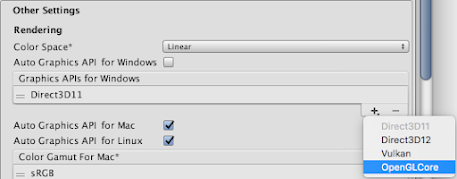Exploring the Power of Graphics API in Unity: Unleashing Visual Excellence
Introduction:
Welcome back, fellow game developers and enthusiasts! Today, we dive into the fascinating world of graphics APIs in Unity. If you're looking to create visually stunning games or want to enhance the visual fidelity of your projects, understanding and utilizing graphics APIs is essential. In this blog post, we'll explore what graphics APIs are, their significance, and how they can be leveraged to unleash the full potential of your Unity creations.
Understanding Graphics APIs:
Graphics API, short for Application Programming Interface, is the intermediary between your game engine (Unity) and your computer's hardware. It provides a set of tools, commands, and protocols that allow developers to communicate and control the rendering pipeline, enabling the creation of immersive visual experiences.
In Unity, there are various graphics APIs available, including:
- DirectX: Developed by Microsoft, DirectX is a collection of APIs designed to interact with Windows-based systems. It offers impressive rendering capabilities, including support for advanced shading techniques, post-processing effects, and high-performance rendering.
- OpenGL: A cross-platform API that supports multiple operating systems, including Windows, macOS, and Linux. It provides developers with a flexible and efficient means to create stunning 2D and 3D graphics, making it a popular choice for many Unity projects.
- Vulkan: This low-level API, developed by the Khronos Group, is designed to provide high-performance, low-overhead access to modern GPUs. Vulkan allows developers to take full advantage of multi-core CPUs and advanced rendering features, improving efficiency and scalability.
- Metal: Exclusive to Apple platforms (iOS, macOS), Metal is a high-performance graphics and compute API. It provides low-level access to the GPU, enabling developers to create visually impressive games with optimized performance on Apple devices.
Optimizing Visual Fidelity:
Graphics APIs play a crucial role in optimizing visual fidelity and performance in Unity. By selecting the appropriate API for your target platform, you can ensure your game utilizes the available hardware resources efficiently, resulting in smoother framerates, reduced latency, and enhanced graphical effects.
Here are some key considerations to optimize visual fidelity using graphics APIs in Unity:
- Platform Compatibility: Understand the target platform for your game and select the appropriate graphics API accordingly. DirectX is commonly used for Windows, while OpenGL and Vulkan are cross-platform options. Metal is exclusive to Apple devices.
- Feature Support: Different APIs offer varying levels of support for advanced graphical features. Research and compare the features each API supports to make an informed decision based on your project's requirements.
- Performance Considerations: Each graphics API has its performance characteristics. Conduct benchmark tests and evaluate the performance impact of different APIs to determine the best fit for your game.
- Flexibility and Customization: Graphics APIs allow developers to implement custom shaders, post-processing effects, and other visual enhancements. Explore the available features and experiment with customization to create a unique visual style for your game.
- Cross-Platform Development: Unity's support for multiple graphics APIs allows developers to create games that can run on various platforms. You can ensure your game reaches a wider audience without sacrificing visual quality by leveraging cross-platform APIs like OpenGL or Vulkan.
- Debugging and Profiling: Different graphics APIs come with their own debugging and profiling tools. Unity provides a robust profiling system that allows you to analyze and optimize your game's performance. Take advantage of these tools to identify bottlenecks, optimize rendering calls, and improve frame rates.
- Mobile Optimization: When developing mobile platforms, choosing graphics APIs optimized for performance on limited hardware resources is crucial. Metal, the graphics API for Apple devices, offers excellent performance on iOS and macOS platforms, enabling you to create visually stunning games with smooth performance.
- Shader Compatibility: Shaders play a significant role in defining the visual appearance of your game. Different graphics APIs may have varying levels of compatibility and support for shader features. Ensure your chosen API supports the shader features your game requires to achieve the desired visual effects.
- Third-Party Integration: Some third-party plugins or tools may have specific requirements or compatibility with certain graphics APIs. Before selecting an API, consider any dependencies in your project and ensure they are compatible with your chosen graphics API.
- Graphics API Updates: Graphics APIs continually evolve, with updates and new features regularly introduced. Stay updated with each API's latest releases and documentation to take advantage of improved performance, bug fixes, and new rendering capabilities.
- Community Support: Unity boasts a vibrant and helpful community of developers who actively share their knowledge and experiences. Engage with the Unity community through forums, blogs, and social media groups to gain insights, learn best practices, and troubleshoot any issues related to graphics APIs.
Remember, selecting the right graphics API for your project involves considering various factors, including the target platform, performance requirements, feature support, and development resources. Experimentation, testing, and iterating are key to finding the perfect fit for your game's visual needs.
OpenGL (Open Graphics Library) is a powerful and widely-used cross-platform graphics API that provides developers with functions and commands to create 2D and 3D graphics. It is an open standard maintained by the Khronos Group, a consortium of technology companies.
Key Features and Capabilities of OpenGL:
- Cross-Platform Compatibility: One of the significant advantages of OpenGL is its cross-platform support. It can be used on various operating systems, including Windows, macOS, Linux, and mobile platforms like Android and iOS. This versatility allows developers to create graphics applications that run on multiple devices without major modifications.
- Hardware Acceleration: OpenGL taps into modern GPUs' underlying hardware acceleration capabilities (Graphics Processing Units), which allows for efficient rendering of complex 2D and 3D graphics. By offloading rendering tasks to the GPU, OpenGL maximizes performance and frees up the CPU for other calculations, resulting in faster and more responsive graphics.
- Graphics Pipeline Control: OpenGL controls the graphics pipeline, the sequence of operations in rendering graphics. Developers can specify and optimize the various stages of the pipeline, including vertex processing, geometry processing, rasterization, and pixel shading. This fine-grained control enables the creation of visually stunning effects and efficient rendering techniques.
- Support for Shaders: Shaders are small programs that run on the GPU and control the visual appearance of objects in a scene. OpenGL supports programmable shaders, such as vertex and fragment shaders, allowing developers to define custom calculations and effects. This flexibility enables various visual styles, from realistic lighting and shadows to stylized graphics.
- Rendering Primitives and Buffer Objects: OpenGL provides functions for rendering basic geometric primitives such as points, lines, and triangles. It also supports using buffer objects, which allow efficient storage and manipulation of vertex data, texture data, and other graphics resources. These features enable developers to create complex 3D models and scenes with ease.
- Texturing and Pixel Manipulation: OpenGL offers extensive texturing and pixel manipulation support. It allows developers to apply textures to 3D models, creates procedural textures, and perform advanced texture mapping techniques. Additionally, OpenGL provides functions for pixel operations, such as blending, filtering, and pixel transfer operations, allowing for precise control over image manipulation.
- Extension Support: OpenGL has a modular architecture allowing extensions to the core API. These extensions provide additional functionality beyond the standard OpenGL specification. Developers can leverage extensions to access advanced features and tailor OpenGL to their needs.
- The abundance of Learning Resources: Due to its popularity and longevity, a wealth of learning resources is available for OpenGL. Documentation, tutorials, books, and community forums provide ample support for developers seeking to learn and master OpenGL.
Conclusion:
OpenGL is a powerful and versatile graphics API that empowers developers to create visually compelling 2D and 3D graphics across various platforms. Its cross-platform compatibility, hardware acceleration, shader support, and extensive feature set make it a popular choice for game developers, CAD applications, scientific visualization, and other graphics-intensive applications.
By understanding the capabilities of OpenGL and leveraging its flexible and efficient rendering pipeline, developers can unlock the potential for creating stunning visual experiences and pushing the boundaries of interactive graphics.
So, whether you're a beginner exploring computer graphics or an experienced developer looking to optimize rendering performance, OpenGL is a valuable tool in your arsenal.
Happy coding, and may your graphics endeavors be a feast for the eyes!
With the power of graphics APIs in Unity, you have the tools to create visually stunning and immersive experiences that captivate players. Embrace the possibilities, push the boundaries, and bring your game's visuals to life!
Happy game development!
Graphics APIs in Unity bridge your game and the hardware, unlocking the potential for breathtaking visuals and optimized performance. By understanding the available options and considering the specific requirements of your project, you can select the ideal graphics API to take your game to the next level.
Experiment, iterate, and fine-tune your visuals using the power of graphics APIs in Unity. Embrace the art of creating immersive visual experiences and captivate your players with stunning graphics. Now, armed with this knowledge, create masterpieces that leave a lasting impact on your audience.
Happy coding and game development!
References:
- Unity Documentation: https://docs.unity3d.com/Manual/GraphicsAPIs.html
- Khronos Group: https://www.khron
- For more details, see https://bleedingedge.studio/blog/

.png)
.jpg)

Comments
Post a Comment